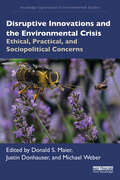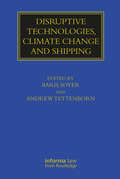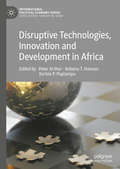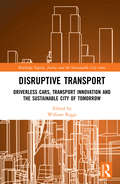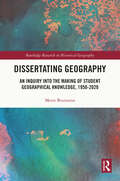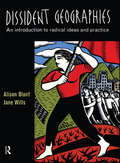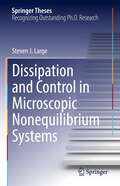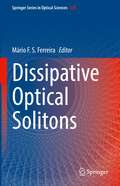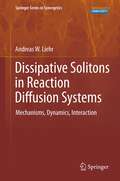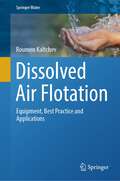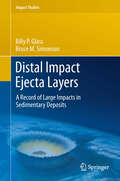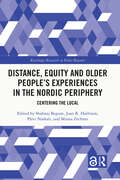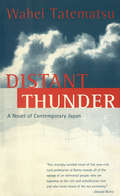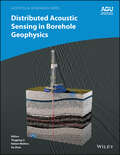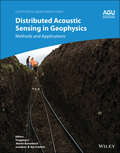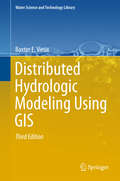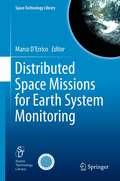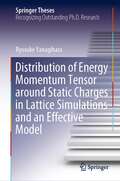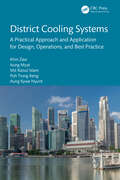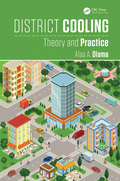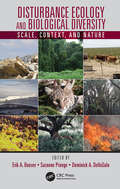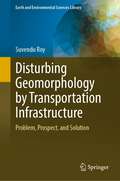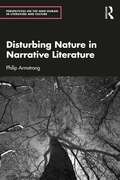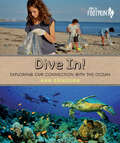- Table View
- List View
Disruptive Innovations and the Environmental Crisis: Ethical, Practical, and Sociopolitical Concerns (Routledge Explorations in Environmental Studies)
by Michael Weber Donald S. Maier Justin DonhauserThis book probes the ethical, practical, and sociopolitical implications of leveraging innovative and disruptive means to address the world’s various environmental crises.Packed with keen observations and analyses, the volume brings together research from seasoned scholars and rising stars to cast important new light on urgent issues engendered by humankind’s disruption of environments, such as climate change and biodiversity loss. It tackles the question of exactly what has been disrupted in the world—environmentally, economically, socially, and politically. It also examines an assortment of innovative interventions that aim to address disruptions and explores the question of what further disruptions may lurk behind assorted innovative interventions intended to address already existing disruptions. Chapters wrestle with the social, ethical, and ecological implications of disruptions, both pre-existing and those brought about by interventions, connected with deploying artificial gene drives, substituting robotic pollinators for living ones, synthesizing organisms to replace ones lost, installing economic regimes that work well for both citizens and the environment, making science subservient to non-scientific commitments, involving citizens in environmentally consequential decisions, choosing scientific and technological projects that most promise immediate practical payoff, and ensuring that respect for human rights is part and parcel of any technology-infused project. These discussions draw on a rich mix of science, philosophy of science, political theory, economics, sociology, network theory, ethics, and theories of justice and human rights.This book will be of great interest to students and scholars of environmental science, environmental decision-making, ecology, climate change, environmental philosophy, and the philosophy of science.
Disruptive Technologies, Climate Change and Shipping (Maritime and Transport Law Library)
by Simon Baughen Andrew Tettenborn Bariş SoyerThis book analyses the impact of two vital and contemporary developments on shipping law and practice: disruptive technologies and climate change. It considers the impact of these new technologies, honing in on likely emerging issues and unresolved questions, especially about existing and potential private law liabilities and concentrates, from the point of view of English, EU and international law, on the legal implications of climate change and associated environmental risks in the shipping sector. Written by a contributor team drawn from the most experienced and knowledgeable academics and practitioners in shipping law, this treatment of these growing areas of practice will be of great use to lawyers and administrators across the world.
Disruptive Technologies, Innovation and Development in Africa (International Political Economy Series)
by Kobena T. Hanson Korbla P. Puplampu Peter ArthurThis book examines how disruptive technologies and innovation underpin the attainment of a broader development agenda in Africa. Contributors show how distinctive forms of technological innovation can impact critical development processes. For example, disruptive technologies can deepen the ongoing democratic and governance waves in Africa, specifically in the area of contested elections. Similarly, innovations in agriculture, the environment and energy promote changes in value chain agriculture, and the use of sensors to manage e-waste and sustainable energy conservation are also transforming established practices. Furthermore, the role of disruptive technologies and innovation in education, health, financial services and the nature of paid work cannot be ignored. Individually and collectively, the authors discuss and highlight the mechanisms and initiatives that can contribute to the realization of the development goals of African countries, especially in a period where disruptive technologies are rapidly changing how things are done. As a result, this book, which represents one of the most recent systematic efforts to bring together dialogue on disruptive technologies in Africa, will be of particular use and benefit to a wide and an eclectic audience.
Disruptive Transport: Driverless Cars, Transport Innovation and the Sustainable City of Tomorrow (Routledge Equity, Justice and the Sustainable City series)
by William RiggsWith the rise of shared and networked vehicles, autonomous vehicles, and other transportation technologies, technological change is outpacing urban planning and policy. Whether urban planners and policy makers like it or not, these transformations will in turn result in profound changes to streets, land use, and cities. But smarter transportation may not necessarily translate into greater sustainability or equity. There are clear opportunities to shape advances in transportation, and to harness them to reshape cities and improve the socio-economic health of cities and residents. There are opportunities to reduce collisions and improve access to healthcare for those who need it most—particularly high-cost, high-need individuals at the younger and older ends of the age spectrum. There is also potential to connect individuals to jobs and change the way cities organize space and optimize trips. To date, very little discussion has centered around the job and social implications of this technology. Further, policy dialogue on future transport has lagged—particularly in the arenas of sustainability and social justice. Little work has been done on decision-making in this high uncertainty environment–a deficiency that is concerning given that land use and transportation actions have long and lagging timelines. This is one of the first books to explore the impact that emerging transport technology is having on cities and their residents, and how policy is needed to shape the cities that we want to have in the future. The book contains a selection of contributions based on the most advanced empirical research, and case studies for how future transport can be harnessed to improve urban sustainability and justice.
Dissertating Geography: An Inquiry into the Making of Student Geographical Knowledge, 1950-2020 (Routledge Research in Historical Geography)
by Mette BruinsmaThis book examines the history of geography (1950-2020) from a bottom-up perspective. Disciplinary histories often emphasise the pronouncements of established academics, yet student-geographers make up the majority of the overall ‘geographical community’ at any one time. Exploring these efforts of geography students over the last seventy years places the known history of the discipline in a new perspective. A disciplinary history ‘from below’ recognises and acknowledges student dissertations and advances three core propositions: first, they are produced by an overlooked but nonetheless central grouping in the geographical community; second, the rich archival collection of dissertations specifically consulted here contains many excellent geographical knowledge productions that have remained barely read, until now; and third, there is a wish to encourage others to explore similar collections of student knowledge productions held elsewhere. This book will be an important resource for scholars and postgraduate students in Geography, Education and the History and Theory of Geography.
Dissident Geographies: An Introduction to Radical Ideas and Practice
by Jane Wills Alison BluntDissident Geographies is an accessible and lively exploration of radical perspectives in human geography. The perspectives examined in the book reveal and resist certain power relations that have constituted geographical knowledge. The book has two main aims. First, rather than reify 'the' geographical tradition, Dissident Geographies introduces a number of geographical traditions that challenge and destabilize what counts as geographical knowledge. Second, the book shows how the production of geographical knowledge is tied to politics and struggles outside as well as within the academy. In each chapter, case studies illustrate the spatiality of political practice and the politics of geographical thought. In this way Dissident Geographies reveals the connections between power, politics and geographical knowledge.
Dissipation and Control in Microscopic Nonequilibrium Systems (Springer Theses)
by Steven J. LargeThis thesis establishes a multifaceted extension of the deterministic control framework that has been a workhorse of nonequilibrium statistical mechanics, to stochastic, discrete, and autonomous control mechanisms. This facilitates the application of ideas from stochastic thermodynamics to the understanding of molecular machines in nanotechnology and in living things. It also gives a scale on which to evaluate the nonequilibrium energetic efficiency of molecular machines, guidelines for designing effective synthetic machines, and a perspective on the engineering principles that govern efficient microscopic energy transduction far from equilibrium. The thesis also documents the author’s design, analysis, and interpretation of the first experimental demonstration of the utility of this generally applicable method for designing energetically-efficient control in biomolecules. Protocols designed using this framework systematically reduced dissipation, when compared to naive protocols, in DNA hairpins across a wide range of experimental unfolding speeds and between sequences with wildly different physical characteristics.
Dissipative Optical Solitons (Springer Series in Optical Sciences #238)
by Mário F. S. FerreiraThis book introduces the basic concept of a dissipative soliton, before going to explore recent theoretical and experimental results for various classes of dissipative optical solitons, high-energy dissipative solitons and their applications, and mode-locked fiber lasers.A soliton is a concept which describes various physical phenomena ranging from solitary waves forming on water to ultrashort optical pulses propagating in an optical fiber. While solitons are usually attributed to integrability, in recent years the notion of a soliton has been extended to various systems which are not necessarily integrable. Until now, the main emphasis has been given to well-known conservative soliton systems, but new avenues of inquiry were opened when physicists realized that solitary waves did indeed exist in a wide range of non-integrable and non-conservative systems leading to the concept of so-called dissipative optical solitons. Dissipative optical solitons have many unique properties which differ from those of their conservative counterparts. For example, except for very few cases, they form zero-parameter families and their properties are completely determined by the external parameters of the optical system. They can exist indefinitely in time, as long as these parameters stay constant. These features of dissipative solitons are highly desirable for several applications, such as in-line regeneration of optical data streams and generation of stable trains of laser pulses by mode-locked cavities.
Dissipative Solitons in Reaction Diffusion Systems
by Andreas W. LiehrWhy writing a book about a specialized task of the large topic of complex systems? And who will read it? The answer is simple: The fascination for a didactically valuable point of view, the elegance of a closed concept and the lack of a comprehensive disquisition. The fascinating part is that field equations can have localized solutions exhibiting the typical characteristics of particles. Regarding the field equations this book focuses on, the field phenomenon of localized solutions can be described in the context of a particle formalism, which leads to a set of ordinary differential equations covering the time evolution of the position and the velocity of each particle. Moreover, starting from these particle dynamics and making the transition to many body systems, one considers typical phenomena of many body systems as shock waves and phase transitions, which themselves can be described as field phenomena. Such transitions between different level of modelling are well known from conservative systems, where localized solutions of quantum field theory lead to the mechanisms of elementary particle interaction and from this to field equations describing the properties of matter. However, in dissipative systems such transitions have not been considered yet, which is adjusted by the presented book. The elegance of a closed concept starts with the observation of self-organized current filaments in a semiconductor gas discharge system. These filaments move on random paths and exhibit certain particle features like scattering or the formation of bound states. Neither the reasons for the propagation of the filaments nor the laws of the interaction between the filaments can be registered by direct observations. Therefore a model is established, which is phenomenological in the first instance due to the complexity of the experimental system. This model allows to understand the existence of localized structures, their mechanisms of movement, and their interaction, at least, on a qualitative level. But this model is also the starting point for developing a data analysis method that enables the detection of movement and interaction mechanisms of the investigated localized solutions. The topic is rounded of by applying the data analysis to real experimental data and comparing the experimental observations to the predictions of the model. A comprehensive publication covering the interesting topic of localized solutions in reaction diffusion systems in its width and its relation to the well known phenomena of spirals and patterns does not yet exist, and this is the third reason for writing this book. Although the book focuses on a specific experimental system the model equations are as simple as possible so that the discussed methods should be adaptable to a large class of systems showing particle-like structures. Therefore, this book should attract not only the experienced scientist, who is interested in self-organization phenomena, but also the student, who would like to understand the investigation of a complex system on the basis of a continuous description.
Dissolved Air Flotation: Equipment, Best Practice and Applications (Springer Water)
by Roumen KaltchevThis book provides an overview of the dissolved air flotation clarification technology. It brings together the three strands of knowledge and experience accumulated in this field - the analysis of the main phenomena involved and the interactions between them, the equipment for its implementation and its main applications in water treatment. The author draws attention to the design and operation of the different equipment used in practice, their advantages, and disadvantages in the different fields of application of this technology.The book is intended for:•Engineers and technicians working on the design of equipment and its integration into the overall water treatment plant as well as in the operation of flotation plants.•Consultants and engineering offices, hoping that it will help them to make the most appropriate choices regarding the applications of this process, as well as in the equipment selections.•Wastewater treatment plants operators, in the hope that it will help them to optimise the operation of their plants and improve their understanding and analysis of some problems they may encounter.•Purchasers and contractors, who have to make sometime difficult choices for reducing costs and, at the same time, ensure and guarantee the long-term performance and reliability of the plant.The book is oriented towards the practical side of implementing the technology. It contains a lot of information about the equipment (much more than in all other available publications on the same subject) as well as practical comments and recommendations that are very rarely found in this kind of book, written mostly by researchers. It will appeal to specialists who are comfortable with water chemistry, but it may also be of interest to water professionals who are more interested in the equipment, design and operation of water treatment plants.
Distal Impact Ejecta Layers
by Billy P. Glass Bruce M. SimonsonImpact cratering is an important geological process on all solid planetary bodies, and, in the case of Earth, may have had major climatic and biological effects. Most terrestrial impact craters have been erased or modified beyond recognition. However, major impacts throw ejecta over large areas of the Earth's surface. Recognition of these impact ejecta layers can help fill in the gaps in the terrestrial cratering record and at the same time provide direct correlation between major impacts and other geological events, such as climatic changes and mass extinctions. This book provides the first summary of known distal impact ejecta layers
Distance, Equity and Older People’s Experiences in the Nordic Periphery: Centering the Local (Routledge Research in Polar Regions)
by Shahnaj Begum Päivi Naskali Joan R. Harbison Minna ZechnerThis book demonstrates how the largely neglected and multifaceted concept of distance can be used as a primary lens to expand and enrich our understandings of what older people say about their lives, needs and wishes in diverse surroundings in the Northern periphery and beyond. It asks how physical, social and emotional distances shape older people’s everyday lives and practices. Contributions from leading experts provides interdisciplinary investigations into the experiences and stories of older people in the Northern periphery. These insights demonstrate the utility of the concept, distance, when reflecting on the central aspects of contemporary ageing societies. The book explores key themes such as care, age politics, technology, intergenerational relations and migration, providing perspectives that are applicable across a variety of international geographical contexts. This innovative book offers a valuable theoretical and methodological contribution with critical new perspectives on ageing in relation to distances. It will be of interest to students and scholars interested in sociology, human geography, health and social care, ageing and gerontological studies, gender studies and Arctic studies.
Distance, Equity and Older People’s Experiences in the Nordic Periphery: Centering the Local (Routledge Research in Polar Regions)
by Shahnaj Begum Päivi Naskali Joan R. Harbison Minna ZechnerThis book demonstrates how the largely neglected and multifaceted concept of distance can be used as a primary lens to expand and enrich our understandings of what older people say about their lives, needs and wishes in diverse surroundings in the Northern periphery and beyond. It asks how physical, social and emotional distances shape older people’s everyday lives and practices. Contributions from leading experts provides interdisciplinary investigations into the experiences and stories of older people in the Northern periphery. These insights demonstrate the utility of the concept, distance, when reflecting on the central aspects of contemporary ageing societies. The book explores key themes such as care, age politics, technology, intergenerational relations and migration, providing perspectives that are applicable across a variety of international geographical contexts. This innovative book offers a valuable theoretical and methodological contribution with critical new perspectives on ageing in relation to distances. It will be of interest to students and scholars interested in sociology, human geography, health and social care, ageing and gerontological studies, gender studies and Arctic studies.
Distant Thunder
by Wahei TatematsuWinner of the Noma Prize for New WritersSet in rural Japan at the height of the bubble economy, Distant Thunder tells of a farming village gradually effaced by urbanization, corruption, and greed. After Matsuzo Wada has sold off the family's lands and left his wife for another woman, his son Mitsuo is determined to support himself and his mother in the traditional manner, farming. All that remains of his ancestors' lands is a hothouse, in which he grows tomatoes to sell to the housewives from the nearby apartment complex, built on a former rice field. When his childhood friend, Koji, becomes entangled in an adulterous love affair which ultimately destroys him and those around him, Mitsuo begins to see how the town's hedonistic excesses are laying to waste not only the landscape, but also the communal and familial bonds and the values that once sustained them all.Translated from the Japanese by Lawrence J. Howell and Hikaru Morimoto.
Distributed Acoustic Sensing in Borehole Geophysics (Geophysical Monograph Series #288)
by Yingping Li Robert Mellors Ge ZhanDistributed Acoustic Sensing in Borehole Geophysics Borehole geophysics involves measuring, imaging, and monitoring subsurface structures and activities by putting instruments into wellbores. Distributed acoustic sensing (DAS) technology is emerging as an effective and reliable tool in borehole geophysics because fiber-optic cables deployed at depth can produce high-quality data and images, even in harsh high-temperature and high-pressure environments. Distributed Acoustic Sensing in Borehole Geophysics is a comprehensive handbook on cutting-edge advances in borehole DAS technologies and their practical applications across geophysics. Volume highlights include: Summary of the evolution of DAS technologies and their primary applicationsNew developments in borehole DAS instrumentation and modelingExamples of DAS data acquisition and processing in different contexts Variety of imaging methods and techniques for integration of images with other data Applications of borehole DAS systems, including monitoring earthquakes and hydraulic fracturing operationsCase studies of borehole DAS projects at diverse sites around the world, ranging from glaciers to geothermal fields The American Geophysical Union promotes discovery in Earth and space science for the benefit of humanity. Its publications disseminate scientific knowledge and provide resources for researchers, students, and professionals.
Distributed Acoustic Sensing in Geophysics: Methods and Applications (Geophysical Monograph Series #268)
by Yingping Li Martin Karrenbach Jonathan B. Ajo-FranklinDistributed Acoustic Sensing in Geophysics Distributed Acoustic Sensing in Geophysics Methods and Applications Distributed Acoustic Sensing (DAS) is a technology that records sound and vibration signals along a fiber optic cable. Its advantages of high resolution, continuous, and real-time measurements mean that DAS systems have been rapidly adopted for a range of applications, including hazard mitigation, energy industries, geohydrology, environmental monitoring, and civil engineering. Distributed Acoustic Sensing in Geophysics: Methods and Applications presents experiences from both industry and academia on using DAS in a range of geophysical applications. Volume highlights include: DAS concepts, principles, and measurements Comprehensive review of the historical development of DAS and related technologies DAS applications in hydrocarbon, geothermal, and mining industries DAS applications in seismology DAS applications in environmental and shallow geophysics The American Geophysical Union promotes discovery in Earth and space science for the benefit of humanity. Its publications disseminate scientific knowledge and provide resources for researchers, students, and professionals.
Distributed Hydrologic Modeling Using GIS
by Baxter E. VieuxThis book presents a unified approach for modeling hydrologic processes distributed in space and time using geographic information systems (GIS). This Third Edition focuses on the principles of implementing a distributed model using geospatial data to simulate hydrologic processes in urban, rural and peri-urban watersheds. The author describes fully distributed representations of hydrologic processes, where physics is the basis for modeling, and geospatial data forms the cornerstone of parameter and process representation. A physics-based approach involves conservation laws that govern the movement of water, ranging from precipitation over a river basin to flow in a river. Global geospatial data have become readily available in GIS format, and a modeling approach that can utilize this data for hydrology offers numerous possibilities. GIS data formats, spatial interpolation and resolution have important effects on the hydrologic simulation of the major hydrologic components of a watershed, and the book provides examples illustrating how to represent a watershed with spatially distributed data along with the many pitfalls inherent in such an undertaking. Since the First and Second Editions, software development and applications have created a richer set of examples, and a deeper understanding of how to perform distributed hydrologic analysis and prediction. This Third Edition describes the development of geospatial data for use in Vflo(r) physics-based distributed modeling.
Distributed Space Missions for Earth System Monitoring
by Marco D'ErricoThis title analyzes distributed Earth observation missions from different perspectives. In particular, the issues arising when the payloads are distributed on different satellites are considered from both the theoretical and practical points of view. Moreover, the problems of designing, measuring, and controlling relative trajectories are thoroughly presented in relation to theory and applicable technologies. Then, the technological challenges to design satellites able to support such missions are tackled. An ample and detailed description of missions and studies complements the book subject.
Distribution of Energy Momentum Tensor around Static Charges in Lattice Simulations and an Effective Model (Springer Theses)
by Ryosuke YanagiharaThe energy momentum tensor (EMT) is one of the most fundamental observables in physics. Recently, a novel method to define EMT on the basis of the gradient-flow formalism has been proposed. It turned out that the EMT operator can be constructed even on the lattice with the method, which enables non-perturbative computations. This approach has been successfully applied to the analyses on thermodynamic quantities.This book presents the study on spatial EMT distributions around static charges via the gradient flow in lattice simulations based on SU(3) Yang-Mills theory. Static charges are employed as probes to explore complex quantum systems, and EMT then characterizes the response of vacuum as well as hot medium under the existence of the charges, which significantly provides profound and novel insights into the non-perturbative phenomena, such as the confinement of quarks. In addition, the book treats the study on the EMT distribution around a magnetic vortex in the Abelian-Higgs model, which is compared with the lattice result. These achievements open up various future studies for revealing non-trivial aspects of the strong interaction.The book also includes well-organized reviews on general properties of EMT, lattice gauge theory and the gradient-flow formalism with its application to the definition of EMT. They are useful for students and young researchers as a brief introduction to this field.
District Cooling Systems: A Practical Approach and Application for Design, Operations, and Best Practice
by Aung Myat Md Raisul Islam Khin Zaw Poh Tiong Keng Aung Kywe NyuntThis book draws on the authors’ industry and academic expertise to explain the theory and practice of district cooling systems (DCS). The in-depth exploration of the design and development of DCS presents detailed best practices for their optimization in both the development and operation phases.Readers will gain in-depth practical knowledge on all areas and considerations related to DCS technology's best practices, including current practical research areas and future potential research areas. This book addresses five areas related to DCS: the fundamentals of DCS technology, design optimization for development purposes, real-time optimization for daily operations, techno-commercial decision-making framework, and industry best practice. This information is presented through analyses of technological progress to date; case studies of current operations; and in-depth discussions of the theoretical bases and commercial, technical, and environmental benefits. Through this book, readers can recognize and apply best practices for the design, development, and operation of an optimal DCS design based on multiple factors including financial analysis, energy efficiency considerations, and practical operation issues. This will enable them to contribute to national and international sustainable development goals regarding sustainable cities and climate action.As this book provides both industry know-how and future research directions related to DCS, it is invaluable for DCS industry professionals and advanced undergraduate and postgraduate engineering students who aim to enter this industry and develop leading, highly efficient DCS systems. Overall, it is a vital resource for anyone involved in the planning, execution, and management of DCS projects.
District Cooling: Theory and Practice (Heat Transfer #7)
by Alaa A. OlamaDISTRICT COOLING: THEORY and PRACTICE provides a unique study of an energy cogeneration system, set up to bring chilled water to buildings (offices, apartment houses, and factories) needing cooling for air conditioning and refrigeration. In winter, the source for the cooling can often be sea water, so it is a cheaper resource than using electricity to run compressors for cooling. The related technology of District Heating has been an established engineering practice for many years, but District Cooling is a relatively new technology now being implemented in various parts of the world, including the USA, Arab Emirates and Kuwait, and Saudi Arabia. Existing books in the area are scarce, and do not address many of the crucial issues facing nations with high overall air temperatures, many of which are developing District Cooling plans using sea water. DISTRICT COOLING: THEORY & PRACTICE integrates the theory behind district cooling planning with the practical engineering approaches, so it can serve the policy makers, engineers, and planners whose efforts have to be coordinated and closely managed to make such systems effective and affordable. In times of rising worldwide temperatures, District Cooling is a way to provide needed cooling with energy conservation and sustainability. This book will be the most up-to-date and comprehensive study on the subject, with Case Studies describing real projects in detail.
Disturbance Ecology and Biological Diversity: Context, Nature, and Scale
by Erik A. Beever Inger Suzanne Prange Dominick A. DellaSalaThis book presents cascading effects of ecological disturbances on a multitude of ecosystem components. It includes agricultural development, large infrequent disturbances, forest harvesting, non-native grazing in deserts, ground transportation, powerline corridors, fires, urban ecology, disturbance in aquatic ecosystems, land-use dynamics on diversity, habitat fragmentation, sedimentation of wetlands, and contemporary climate change. The book facilitates users in understanding why disturbances are occurring while recommending mitigation and remediation strategies.
Disturbing Geomorphology by Transportation Infrastructure: Problem, Prospect, and Solution (Earth and Environmental Sciences Library)
by Suvendu RoyThis book focuses on a significant branch of anthropogeomorphology, which is not adequately studied: the impact of transportation systems on altering earth surface processes and landforms. This book fills the gap with in-depth study on the interaction between individual modes of transport network (e.g., trail, roads, railways, waterways, airports, and tunnel) and surface hydro-geomorphology with intensive literature review, fieldwork, geo-environmental modelling, mapping, case studies, and examples from different parts of the world. On the one hand, this book also addresses the vulnerability of transport networks from climate change and critical geo-hazards like floods, landslides, etc. with case studies from the high-risk zones of India. Overall, this book promotes peaceful harmony between the transport network and its surrounding landscapes as an essential lesson for policymakers, planners, and stakeholders.
Disturbing Nature in Narrative Literature (Perspectives on the Non-Human in Literature and Culture)
by Philip ArmstrongDisturbing Nature in Narrative Literature identifies and analyses encounters with unexpected, disconcerting, and unsettling aspects of the natural world, as these have been represented across a wide range of literary texts. It includes in‑depth discussion of both familiar and less familiar works from the British, American, and European literary traditions, and from the Classical period to today. The motifs discussed include earthquakes, forests, storms, animals, and oceanic depth, and the writers include Virgil, Ovid, Dante, Shakespeare, Aphra Behn, Voltaire, Heinrich von Kleist, Herman Melville, H.G. Wells, J.R.R. Tolkien, Gabriel García Márquez, José Saramago, Margaret Atwood, and Annie Proulx. Rich in both close textual analysis and contextual discussion, Disturbing Nature in Narrative Literature offers a vivid introduction to several topical approaches to literary‑critical analysis, including ecocriticism, new materialism, affect theory, and human‑animal studies, thereby demonstrating how literature shapes and is shaped by our response to the pressing questions of our time.
Dive In!: Exploring Our Connection with the Ocean (Orca Footprints #14)
by Ann ErikssonWe're all connected to the ocean, and the ocean to us. The ocean provides half the oxygen we breathe; it feeds us, creates our weather and provides us with water. But we haven't been as kind to the ocean in return. The problems are many: pollution, overfishing, rising seas and acid waters. What can be done? Don't despair; take action. Dive In! explores our intimate connection with the ocean and provides every reader with an achievable set of actions that can help improve ocean health for our sake and the sake of the millions of marine plants and animals that share the planet with us. Filled with colorful photos and positive stories, Dive In! is as informative as it is inspirational. The epub edition of this title is fully accessible.
